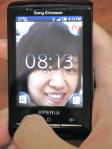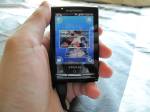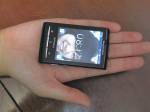It’s been awhile since I last tested an Android phone so it was with anticipation that I unwrapped the HTC Desire Z that was delivered to my desk. My anticipation quickly dissipated when I unwrapped a dirty, smudged-ridden grey-silver bodied smartphone.
I knew this unit to have a physical keyboard because of the two thin slabs of plastic that seemingly looked stuck to each other. But for a few minutes I could not separate the two slabs to expose the keyboard. Then something happened – my two thumbs working instinctively flipped the one side of the upper slab and voila, the keyboard laid bare before me. For a moment, it was like magic.
The HTC Desire Z is one of more attractive phones I’ve had the pleasure of reviewing. HTC’s designers are starting to get good at industrial design. An odd design I found wanting in most HTC phones is the way to access the battery and SIM slot at the back of the phone. It usually involves prying lose a plastic cover. In the Desire Z, HTC introduced a back cover lock that unlatches the brushed aluminum cover to expose the battery, SIM and micro SD card slots.
At 164g this is not a light phone but you’d expect that given it has a full qwerty keyboard (with a solid feel to it – more on this later). I was expecting this to be using a 1GHz snapdragon given the speed with which it handled my fingered commands (that didn’t sound right) but the spec says its uses an 800MHz Qualcomm processor. I am sure the 1.5GB User memory ROM has something to do with the speed.
The round edges of the phone means you can slip it in and out of the pocket without worrying it will punch holes or poke your leg unduly. I found it interesting that the optical trackpad is clickable, offering a tactile response to specific commands.
A distinguishing feature of the Desire Z is the slideout keyboard. I had some initial concerns with the slide-out keyboard but these were soon dispelled. The gray rubber coating around the aluminum battery door offered a secure and comfortable grip when typing on the keyboard.
Like most mid- to high-end smartphones, the Desire Z is equipped with a 5-megapixel digital camera that can also shoot 720p HD video. For dimly situations, there is a LED flash. The camera is actually not that bad. Zooming, focusing and shooting is very smooth and the quality of the shots are surprisingly ok for a camera phone.
As with the best of present-day smartphones, the Desire Z is built for connectivity – HSDPA, Wi-Fi, Bluetooth and A-GPS.
I’m going to refer back to what Apple claims is a key selling point of the iPhone 4 – a high resolution display that can show the details of freckles. But as I wrote in my report on the HTC HD7 – who would want to do that? As long as you can comfortably watch a video or see photos clearly on such a small screen, that should be enough.
WHAT I LIKE
The HTC Sense is the software that makes for easier navigation and access to some of the features of this smartphone. Of the many Android phones out in the market, HTC Sense is one of my favorites. I’d argue that its probably one of the most tweaked since it’s one of the earliest user interface created for the Android operating system. I do confess, however, that I was never a fan of the HTC TouchFLO, the predecessor of the Sense.
The 3.7″ screen is not AMOLED but don’t let that distract you from the quality of the display. You can watch any movie or surf a website with reasonable quality and comfort.
I like the fact that this phone is priced much lower than the HTC HD series but still performs almost on par with its much more powerful siblings. While I also like to have a physical keyboard as I still make too many mistakes typing on a touchscreen, I think you will see from my comment below that my experience with the keyboard isn’t exactly what I’d call a running success.
WHAT I DON’T LIKE
The qwerty keyboard looks solid and impressive. HTC raised the keys slightly to make typing more efficient. But my experience typing on it is less than satisfactory. I actually found it easier to type on the screen even though I prefer a physical keyboard when typing messages. I also found the the position of the tab key on the left very annoying as I often pressed it mistakenly for the “a”. I also found myself pressing harder than expected to enter a key. This action becomes annoying if you consider that typing a short SMS message should’t take too long. One thing to note is that using the keyboard the Desire Z, you can’t type on the keyboard with one hand. On the BlackBerry Torch 9800 (and most other BBs) I can still type with one hand albeit a little slower than I’d like.
I wrote praises for the Desire Z’s camera but I have to tell you that despite the quality of the shots, I still find it difficult to take those candid shots with ease and speed. This, like most smart phones with cameras, is not your standard point and shoot camera. A steady hand is definitely a must as is more time to set the scene for the shot.
One thing that annoys me consistently with all touch devices (with the exception of the BlackBerry 9800) is the lack of way to lock the screen. For instance, when watching a video I almost always accidentally touch the screen resulting in the video pausing. On the Torch 9800 the buttons that appear to be sensitive to the touch are the mute and power buttons. On most touch other touch phones, this is anything on the screen. In all the tests I’ve conducted, this is a consistent experience. Very annoying if you like to have a quiet time between you, your player, and the video you are trying to watch. (more…)






